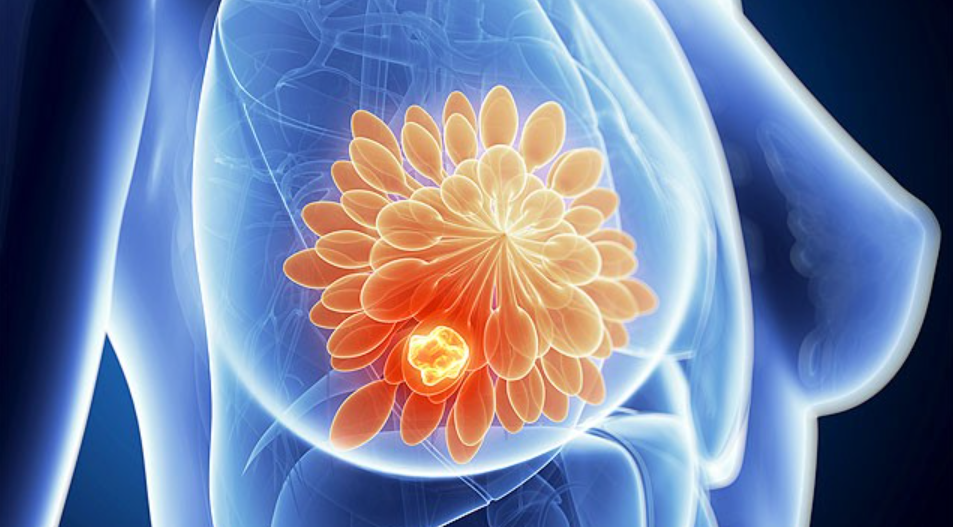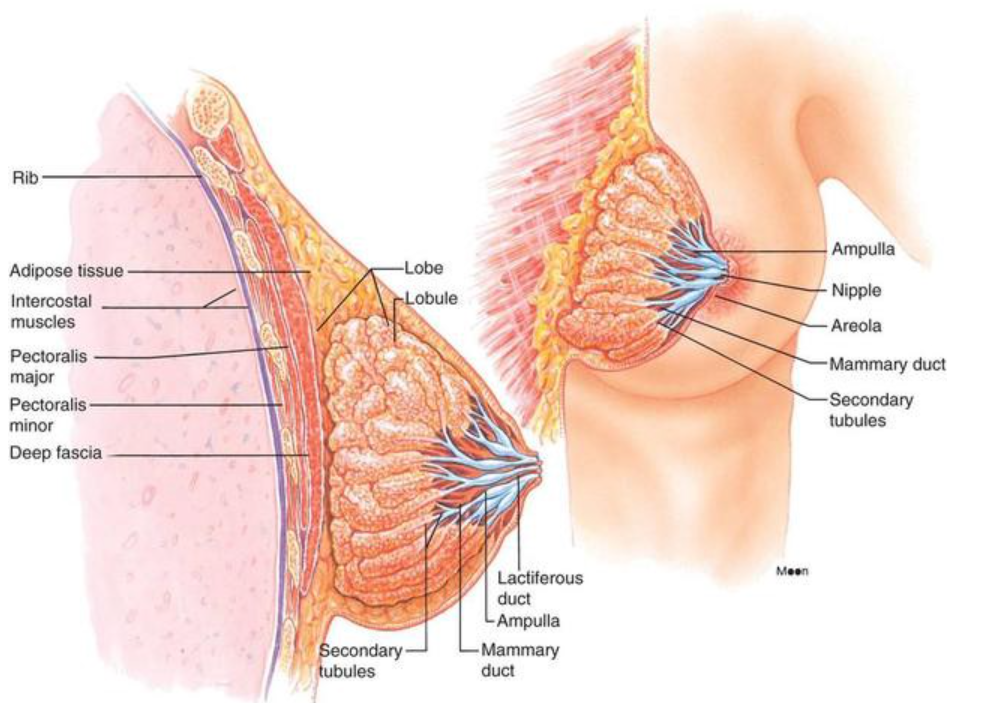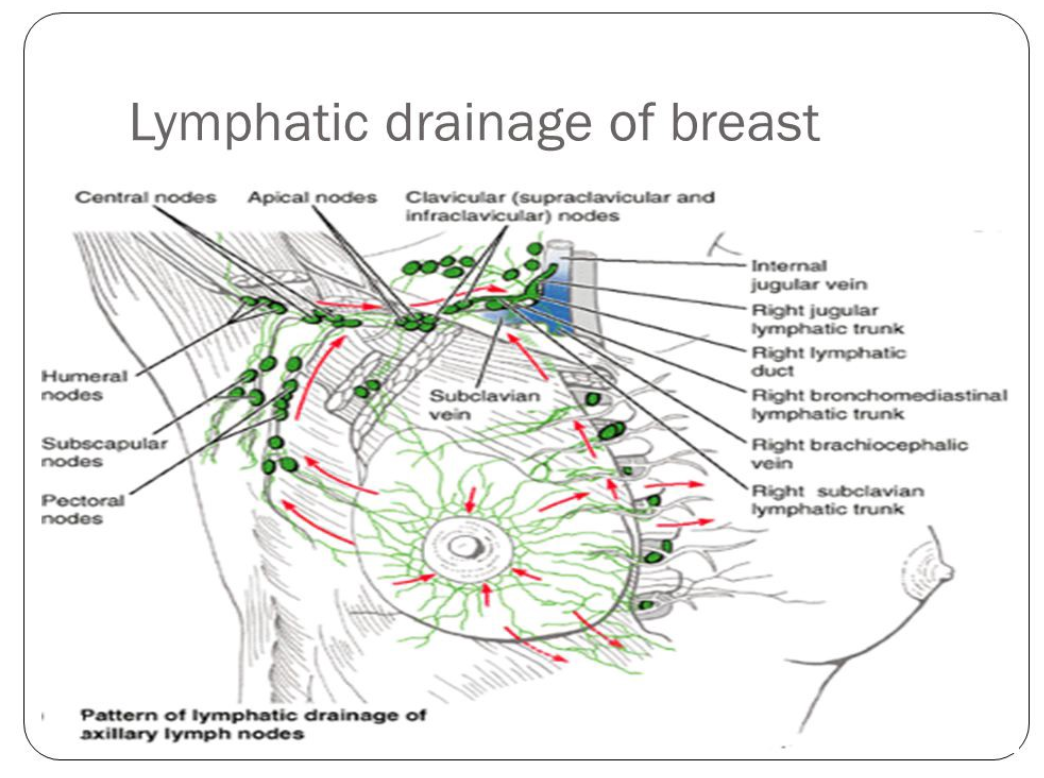Here’s What You Need to Know About BRCA 1 and 2: The Breast Cancer Genes
Your genes may hold the secret to breast cancer susceptibility. Read more
Your genes may hold the secret to breast cancer susceptibility. Read more
Understanding the mystery of the mammary glands.
We all have breasts. Structurally, breasts are simply modified sweat glands. But functionally, the mammary glands produce milk, life- saving nutrition for newborn babies allowing the human race to evolve and flourish.
The mammary glands are wondrous and complex structures. Let’s take a tour of the breast anatomy.

Used with permission from Medika Life
Mammary glands are located in the breast overlying the pectoralis major muscles. Both males and females have them, but they are functional only in women.
Externally, each breast has a raised nipple surrounded by a circular pigmented area called the areola. The nipples are sensitive to touch because of a dense array of nerve fibers and smooth muscle that contracts and causes them to become erect in response to stimulation.
Internally, the adult female breast contains 15 to 20 lobes of glandular tissue that radiate around the nipple. The lobes are separated by firm connective tissue and fatty adipose tissue.
The connective tissue helps support the breast. Bands of connective tissue, called suspensory (Cooper’s) ligaments, extend through the breast from the skin to the underlying muscles. The amount and distribution of the adipose tissue determine the size and shape of the breast. To keep it simple, fatty tissue determines breast size and connective tissue holds them up.
Have you ever wondered how milk gets to the nipple? Each lobe consists of lobules that contain the milk-producing glandular units. A tube called a lactiferous duct collects milk from the lobules and carries it to the nipple.
Milk is stored in a reservoir called the ampulla (lactiferous sinus) just before arrival at the nipple. After the sinus, the duct splits and narrows allowing multiple ducts to bring milk to the surface of the nipple.
Four hormones have an integral role in breast development. Estrogen levels increase during puberty and stimulate the production of glandular breast tissue. Estrogen increases adipose tissue causing the breast to increase in size. Progesterone plays a role as well by stimulating the development of the duct system.
During pregnancy, these hormones further enhance the development of the mammary glands. Prolactin from the anterior pituitary gland stimulates the milk production inside of the glandular tissue, and oxytocin triggers the ejection of milk from the glands.

Used with permission from Medika Life
The breast is located on the anterior thoracic wall. It extends horizontally from the lateral border of the sternum to the mid-axillary line. Vertically, it spans between the 2nd and 6thintercostal cartilages. It lies superficially to the pectoralis major and serratus anterior muscles.
The breast is composed of two regions. The circular body is the prominent area of the breast. The axillary tail is a smaller area running along the inferior lateral edge of the pectoralis major towards the axillary fossa.
At the center of the breast is the nipple. It is made mostly of smooth muscle fibers. The pigmented area of skin surrounding the nipple is called the areolae. There are numerous sebaceous glands within the areolae . These glands enlarge during pregnancy, secreting an oily protective lubricant for the nipple.
The middle of the breast receives blood from the internal mammary artery, a branch of the subclavian artery.
The lateral part of the breast receives blood from four vessels:

Used with permission from Medika Life
The lymphatic drainage of the breast is incredibly important. Breast cancer spreads through the lymph when it spreads (metastisizes).
There are three groups of lymph nodes that receive lymph from breast tissue — the axillary nodes (75%), parasternal nodes (20%), and posterior intercostal nodes (5%).
Thank you to BeingWell for publishing this article on Medium.
Originally posted on Medika Life
Blog Author: Dr. Richard Wagner
Main Blog Photo By: Jan Kopřiva on Unsplash
A few years ago, I found my own breast mass Read more
The internet is a fantastic thing — Endless information at our disposal within seconds. While the internet has made it easy for women to find information on topics such as breast cancer, it also is ripe with bogus information. Myths about breast cancer are often circulated online and through social media. Here are five common breast cancer myths:
Read more
Why do breasts hurt sometimes.
Up to 70% of women will experience breast pain (or mastalgia) during their lifetime. Patients may notice breast pain and become concerned. People worry it may be an early sign of breast cancer. Breast pain without any other symptoms, such as a breast mass or lump, is rarely a sign of breast cancer.
Breast cancer should be ruled out with a physical exam and possibly imaging for any breast complaint. Don’t ignore it. If you are concerned about a breast issue then we want to address it with you. For the sake of this article, however, we will be focusing on breast pain not associated with cancer.
What else is causing the pain?
We can break it down into two broad categories: cyclical and non-cyclical.
Cyclical breast pain is the most common. It usually affects both breasts. It typically begins in the days leading up to your period and improves after you start your period. Cyclical pain is associated with the normal hormonal fluctuations of the menstrual cycle.
Increased levels of estrogen and progesterone in the blood stimulate the proliferation of the normal glandular tissue in the breasts. The hormonal fluctuation results in pain. Because cyclical breast pain is caused by hormones in the blood, it can also be triggered if you are taking birth control pills or hormone replacement pills.
Non-cyclical breast pain does not follow the usual menstrual pattern. It is more variable, more likely to be in just one breast, and either be constant or intermittent in nature.
Causes of this type of pain vary. Causes include breast cysts, infection or abscess, and even your diet. Cutting back on caffeine has been shown to improve breast pain in some women. Large, pendulous breasts can cause pain due to stretching of the ligaments in the breast, known as Cooper’s ligaments.
If your pain is cyclical or non-cyclical, you should always discuss any concerns with your doctor. Your doctor is a good resource to address your concerns.
Thank you to BeingWell for publishing this article on Medium.
Main Blog Photo By: Unsplash
Blog Author: Dr. Richard Wagner
October is Breast Cancer Awareness Month and the best thing you can do is educate yourself. Read more